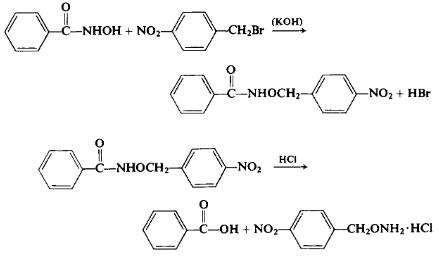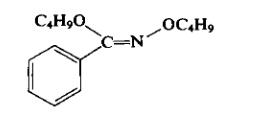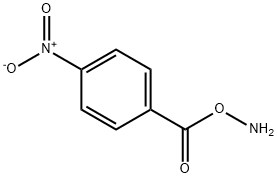O-(4-NITROBENZYL)HYDROXYLAMINE HYDROCHLORIDE
Synonym(s):4-Nitrobenzyloxyamine hydrochloride
- CAS NO.:2086-26-2
- Empirical Formula: C7H9ClN2O3
- Molecular Weight: 204.61
- MDL number: MFCD00012954
- EINECS: 218-228-6
- SAFETY DATA SHEET (SDS)
- Update Date: 2025-07-24 18:13:46

What is O-(4-NITROBENZYL)HYDROXYLAMINE HYDROCHLORIDE?
Chemical properties
LIGHT YELLOW POWDER
The Uses of O-(4-NITROBENZYL)HYDROXYLAMINE HYDROCHLORIDE
As a strong UV chromophore, O-(4-Nitrobenzyl)hydroxylamine hydrochloride can be used in derivatization of reducing sugars for ultraviolet absorption detection in HPLC analyses.
The Uses of O-(4-NITROBENZYL)HYDROXYLAMINE HYDROCHLORIDE
A strong UV chromophore used in derivatization of reducing sugars for ultraviolet absorption detection in HPLC analyses.
Preparation
To a solution of 25 gm (0.183 mole) of benzohydroxamic acid in 28 ml of ethanol and 10.2 gm (0.184 mole) of potassium hydroxide in 40 ml of water is added a hot solution of 39.4 gm (0.184 mole) of p-nitrobenzyl bromide in ethanol. The mixture is then heated under a reflux condenser for 45 min and cooled. The precipitated crystals are separated and crystallized from ethanol. (No yield reported.) A solution of 15 gm (0.055 mole) of the above o-p-nitrobenzylbenzohy-droxamic acid (p-nitrobenzyl benzohydroxamate) in 125 ml of hot ethanol is heated to reflux for 25 min with 150 ml of cone, hydrochloric acid. To prevent the precipitation of the final product during the work-up, the following steps are carried out rapidly. The clear solution is diluted with 150 ml of water and while still warm benzoic acid and other by-products are separated by extraction with 200 ml of chloroform. The aqueous layer is evaporated to dryness under reduced pressure to afford a crude yield of 10.75 gm (96%). The residue is recrystallized from hot 2 Ν hydrochloric acid and washed in turn with ethanol and with ether to afford a solid, m.p. 217°C.
The free base may be produced by neutralizing the salt with sodium carbonate solution; O-p-nitrobenzylhydroxylamine, m.p. 56°C (recrystallized from petroleum ether). By a similar technique, O-allylhydroxylamine hydrochloride, m.p. 172°C (dec.) was also prepared.

An examination of the product of butylating benzohydroxamic acid showed that a nonacidic fraction and an equal weight of an acidic fraction were readily isolated. The nonacidic fraction contained mainly Ο, Ο '-dibutyl benzohydroxi-mate (b.p. 175-180°C/13 mm Hg) and some aniline (probably formed during the reaction by a Lossen rearrangement). On hydrolysis with eth-anolic hydrochloric acid, the hydroximate produced ethyl benzoate and O-butylhydroxylamine hydrobromide (m.p. 159-161°C; hydrochloride, m.p. 156-157°C).
The acidic fraction contained mainly O-butylbenzohydroxamic acid (butyl benzohydroxamate) which on hydrolysis formed O-butylhydroxylamine hydrochloride and benzoic acid. It has been contended that in this particular work, the presence of an Ν,Ο-dibutylbenzohy-droxamic acid had been overlooked. The major source of O-butylhydroxylamine hydrochloride is from the acidic fraction, although the yield is not particularly high. The initial preparation of the butylated benzohydroxamic acid derivatives has been repeated recently. The analysis of the reaction products by vapor-phase chromatography showed it to contain 43% of O-butylbenzohydroxamic acid (butyl benzohydroxamate), 17% of iV,0-dibutyl-benzohydroxamic acid, and 8% of n-butyl(Z)-0-n-butylbenzohydroximate:

The nature of the remaining 32% of the crude reaction product was not determined. The use of benzohydroxamic acid has been extended to the preparation of a variety of O-substituted hydroxylamines. For example, halocarboxylic acids have been used as alkylating agents to produce α-aminooxy acids of the type, NH20(CH2)„C02H.
A variety of O-benzylhydroxylamines, O-aralkylhydroxylamines, as well as simpler O-substituted hydroxylamines have also been prepared. In some of these preparations, the hydrolysis of the O-substituted benzohydroxamic acid was carried out with hot alcoholic hydrogen chloride. This treatment evidently prevented the O-N cleavage which had been observed during the aqueous hydrolysis of the substituted benzohydroxamic acids.
Properties of O-(4-NITROBENZYL)HYDROXYLAMINE HYDROCHLORIDE
| Melting point: | 215 °C (dec.)(lit.) |
| Boiling point: | 226°C |
| storage temp. | Keep in dark place,Inert atmosphere,Room temperature |
| solubility | DMSO (Slightly), Methanol (Slightly) |
| form | Solid |
| color | White to Off-White |
| Sensitive | Moisture & Light Sensitive |
| BRN | 3709565 |
| CAS DataBase Reference | 2086-26-2(CAS DataBase Reference) |
| EPA Substance Registry System | Hydroxylamine, O-[(4-nitrophenyl)methyl]-, monohydrochloride (2086-26-2) |
Safety information for O-(4-NITROBENZYL)HYDROXYLAMINE HYDROCHLORIDE
Computed Descriptors for O-(4-NITROBENZYL)HYDROXYLAMINE HYDROCHLORIDE
New Products
4,4-Difluoropiperidine hydrochloride tert-butyl 9-methoxy-3-azaspiro[5.5]undecane-3-carboxylate Indole Methyl Resin N-Isopropylurea N,N-Dicyclohexylcarbodiimide(DCC) MELDRUMS ACID 5-METHYLISOXAZOLE-4-CARBOXYLIC ACID Magnessium Bis glycinate Zinc ascorbate 1-bromo-2-butyne 2-acetamidophenol 9(10H)-anthracenone Erythrosin B, 4-Piperidinopiperidine 2-((4-morpholinophenylamino) (methylthio) methylene) malononitrile 2,4-dihydroxybenzaldehyde 3-(4-morpholinophenylamino)-5-amino-1H-pyrazole-4-carbonitrile Methyl 2-methylquinoline-6-carboxylate 2,6-dichloro-4-nitropyridine 4-Bromo-2-chlorobenzonitrile 2-(benzylamino)acetic acid hydrochloride 4-(tert-Butoxycarbonylamino)but- 2-ynoic acid 3,4-dihydro-2H-benzo[b][1,4]dioxepine 1-Phenyl-1-cycloprppanecarboxylicacidRelated products of tetrahydrofuran

![N-(3,4-DICHLOROPHENYL)-3-([(4-NITROBENZYL)OXY]IMINO)PROPANAMIDE](https://img.chemicalbook.in/StructureFile/ChemBookStructure2/GIF/CB9227071.gif)
![N-[(DIMETHYLAMINO)METHYLENE]-N-[(4-NITROBENZYL)OXY]UREA](https://img.chemicalbook.in/StructureFile/ChemBookStructure2/GIF/CB5120101.gif)
![1-[(([(4-CHLOROPHENYL)METHYLENE]AMINO)OXY)CARBONYL]-4-NITROBENZENE](https://img.chemicalbook.in/StructureFile/ChemBookStructure2/GIF/CB3683888.gif)
![2-[(4-CHLOROPHENYL)SULFANYL]-2-METHYLPROPANAL O-(4-NITROBENZYL)OXIME](https://img.chemicalbook.in/StructureFile/ChemBookStructure2/GIF/CB7234473.gif)
![N-[(METHOXYIMINO)METHYL]-N-[(4-NITROBENZYL)OXY]UREA](https://img.chemicalbook.in/StructureFile/ChemBookStructure2/GIF/CB9322646.gif)
![2-[3-CHLORO-5-(TRIFLUOROMETHYL)-2-PYRIDINYL]-2-METHYL-N-(([(4-NITROBENZYL)OXY]AMINO)METHYLENE)-1-HYDRAZINECARBOXAMIDE](https://img.chemicalbook.in/StructureFile/ChemBookStructure3/GIF/CB5747953.gif)
![6-PHENYLIMIDAZO[2,1-B][1,3]THIAZOLE-5-CARBALDEHYDE O-(4-NITROBENZYL)OXIME](https://img.chemicalbook.in/StructureFile/ChemBookStructure2/GIF/CB4115045.gif)
You may like
-
 O-(4-Nitrobenzyl)hydroxylamine hydrochloride CAS 2086-26-2View Details
O-(4-Nitrobenzyl)hydroxylamine hydrochloride CAS 2086-26-2View Details
2086-26-2 -
 O-(4-Nitrobenzyl)hydroxylamine HCl 95% CAS 2086-26-2View Details
O-(4-Nitrobenzyl)hydroxylamine HCl 95% CAS 2086-26-2View Details
2086-26-2 -
![O-4-Nitrobenzylhydroxylamine Hydrochloride [for HPLC Labeling] CAS 2086-26-2](https://img.chemicalbook.in//Content/image/CP5.jpg) O-4-Nitrobenzylhydroxylamine Hydrochloride [for HPLC Labeling] CAS 2086-26-2View Details
O-4-Nitrobenzylhydroxylamine Hydrochloride [for HPLC Labeling] CAS 2086-26-2View Details
2086-26-2 -
 O-(4-Nitrobenzyl)hydroxylamine hydrochloride CAS 2086-26-2View Details
O-(4-Nitrobenzyl)hydroxylamine hydrochloride CAS 2086-26-2View Details
2086-26-2 -
 3-(4-amino-1-oxoisoindolin-2-yl)-1-methylpiperidine-2,6-dione 98%View Details
3-(4-amino-1-oxoisoindolin-2-yl)-1-methylpiperidine-2,6-dione 98%View Details -
 20677-73-0 (2,2-diethoxyethyl)methylamine 98%View Details
20677-73-0 (2,2-diethoxyethyl)methylamine 98%View Details
20677-73-0 -
 3-(4-(hydroxyamino)-1-oxoisoindolin-2-yl)piperidine-2,6-dione 98%View Details
3-(4-(hydroxyamino)-1-oxoisoindolin-2-yl)piperidine-2,6-dione 98%View Details -
 57381-49-4 2-bromo-4-chlorobenzonitrile 98%View Details
57381-49-4 2-bromo-4-chlorobenzonitrile 98%View Details
57381-49-4
